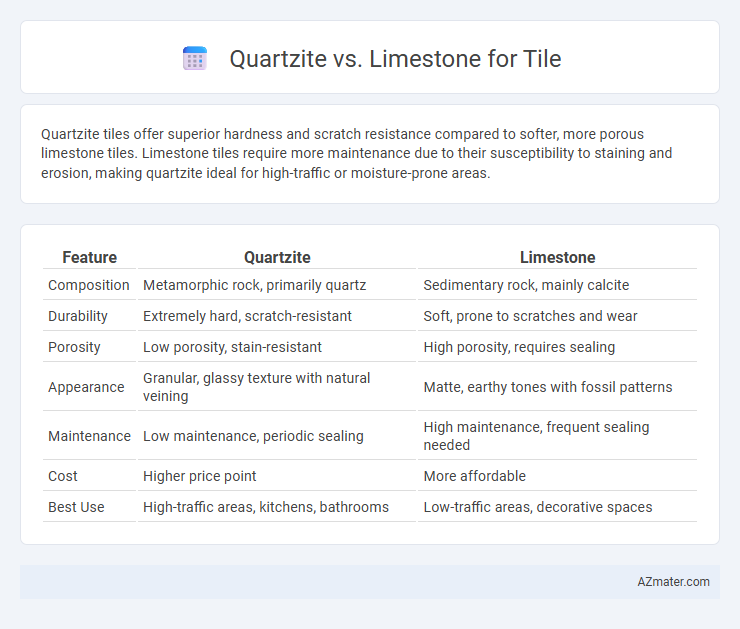Quartzite tiles offer superior hardness and scratch resistance compared to softer, more porous limestone tiles. Limestone tiles require more maintenance due to their susceptibility to staining and erosion, making quartzite ideal for high-traffic or moisture-prone areas.
Table of Comparison
| Feature | Quartzite | Limestone |
|---|---|---|
| Composition | Metamorphic rock, primarily quartz | Sedimentary rock, mainly calcite |
| Durability | Extremely hard, scratch-resistant | Soft, prone to scratches and wear |
| Porosity | Low porosity, stain-resistant | High porosity, requires sealing |
| Appearance | Granular, glassy texture with natural veining | Matte, earthy tones with fossil patterns |
| Maintenance | Low maintenance, periodic sealing | High maintenance, frequent sealing needed |
| Cost | Higher price point | More affordable |
| Best Use | High-traffic areas, kitchens, bathrooms | Low-traffic areas, decorative spaces |
Introduction to Quartzite and Limestone Tiles
Quartzite tiles, formed from natural sandstone exposed to intense heat and pressure, offer exceptional durability and a distinctive, glassy appearance ideal for high-traffic areas. Limestone tiles, composed primarily of calcite derived from marine organisms, provide a softer, porous surface with unique earthy tones and a matte finish suitable for low-traffic indoor spaces. Both materials bring natural stone elegance, requiring specific sealing and maintenance practices to preserve their aesthetic and functional properties.
Composition and Formation
Quartzite forms from sandstone subjected to intense heat and pressure, resulting in a highly durable, metamorphic rock rich in quartz crystals. Limestone is a sedimentary rock primarily composed of calcite, formed through the accumulation of marine organism remains, making it softer and more porous compared to quartzite. The differing mineral compositions and formation processes impact their hardness, porosity, and suitability for tile applications, with quartzite offering superior strength and limestone providing a distinct, natural aesthetic.
Appearance and Color Variations
Quartzite exhibits a natural, glassy sheen with a range of colors including white, gray, blue, and pink, offering a distinct and vibrant appearance for tile applications. Limestone presents a softer, matte finish with earth-toned hues such as beige, cream, and tan, creating a more uniform and subdued look. Both materials provide unique aesthetic qualities, but quartzite stands out for its durability and striking color variations compared to the subtle, classic tones of limestone.
Durability and Hardness
Quartzite offers superior durability and hardness compared to limestone, making it an excellent choice for high-traffic areas and surfaces exposed to wear. With a Mohs hardness rating of 7, quartzite resists scratching and etching better than limestone, which typically ranks between 3 and 4. Limestone's softer composition makes it more susceptible to damage and requires more maintenance in tile applications.
Water and Stain Resistance
Quartzite tiles exhibit superior water and stain resistance compared to limestone due to their dense, non-porous composition that minimizes moisture absorption and reduces susceptibility to staining. Limestone, a sedimentary rock with higher porosity, requires regular sealing to prevent water damage and staining, making it less durable in high-moisture environments. Choosing quartzite for tile ensures enhanced longevity and easier maintenance in kitchens, bathrooms, and outdoor areas where water exposure is frequent.
Maintenance Requirements
Quartzite tiles require minimal maintenance due to their natural hardness and resistance to scratches and stains, making them ideal for high-traffic areas. Limestone tiles, being softer and more porous, demand regular sealing and careful cleaning to prevent staining and etching from acidic substances. Proper maintenance of limestone involves gentle, pH-neutral cleaners and periodic resealing to preserve its appearance and durability.
Installation Process and Challenges
Quartzite tiles require precise cutting and sealing during installation to prevent chipping and enhance durability, making the process more labor-intensive compared to limestone. Limestone tiles are softer and more porous, demanding careful handling and thorough sealing to avoid staining and moisture damage, which can prolong installation time. Both materials pose challenges: quartzite's hardness complicates cutting tools usage, while limestone's sensitivity necessitates gentle installation and frequent maintenance.
Cost Comparison
Quartzite tiles typically cost between $7 and $15 per square foot, reflecting their durability and natural hardness, while limestone tiles range from $5 to $10 per square foot, offering a more budget-friendly option. Installation costs for quartzite are usually higher due to its density and cutting difficulty, averaging $10 to $20 per square foot compared to limestone's $8 to $12 per square foot. Maintenance expenses also favor limestone as quartzite requires more specialized care to preserve its polished finish over time.
Best Applications for Each Material
Quartzite tiles excel in high-traffic areas and outdoor installations due to their exceptional hardness, durability, and resistance to weathering and scratches. Limestone tiles are ideal for interior spaces such as bathrooms and living rooms, offering a softer, more porous surface that enhances warmth and character but requires regular sealing to prevent staining. Selecting quartzite is best for kitchens and entryways where longevity and low maintenance are crucial, whereas limestone suits decorative walls and low-traffic floors for its natural texture and aesthetic appeal.
Pros and Cons: Quartzite vs Limestone
Quartzite tiles offer superior durability and resistance to scratches and stains compared to limestone, making them ideal for high-traffic areas and kitchens. Limestone tiles provide a softer, more natural matte finish with unique fossil patterns, but are more prone to etching and require regular sealing to prevent damage from acids. While quartzite demands less maintenance and offers greater heat resistance, limestone's porous nature can lead to increased vulnerability to water absorption and wear over time.

Infographic: Quartzite vs Limestone for Tile
 azmater.com
azmater.com